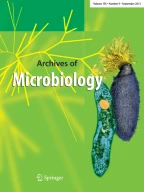768Accesses
6Altmetric
Abstract
Two closely related cysteine-rich hydrophobic proteins, Sc3p and Sc4p, of the basidiomyceteSchizophyllum commune are developmentally regulated and associated with the walls of aerial hyphae and fruit-body hyphae. They are present in the walls as hot-SDS-insoluble complexes which can be extracted with formic acid. The hydrophobins can then be dissociated by oxidation with performic acid. However, extraction of the walls with trifluoroacetic acid results in both solubilization and dissociation of the hydrophobin complexes into monomers. This suggests that non-covalent interactions are responsible for formation of these insoluble complexes. Carboxymethylation with iodoacetic acid only occurred after reduction with DTT indicating all cysteines in the monomeric hydrophobins involved in intramolecular disulfide bridges. Abundant proteins with similar properties were found in walls from all other filamentous fungi tested, including the basidiomycetesPleurotus ostreatus, Coprinus cinereus, Agaricus bisporus, andPhanerochaete chrysosporium, the ascomycetesAspergillus nidulans, Neurospora crassa, andPenicillium chrysogenum, and the zygomyceteMucor mucedo.
This is a preview of subscription content,log in via an institution to check access.
Access this article
Subscribe and save
- Get 10 units per month
- Download Article/Chapter or eBook
- 1 Unit = 1 Article or 1 Chapter
- Cancel anytime
Buy Now
Price includes VAT (Japan)
Instant access to the full article PDF.
Similar content being viewed by others
References
Beever RE, Redgwell RJ, Dempsey GP (1979) Purification and chemical characterization of the rodlet layer ofNeurospora crassa conidia. J Bacteriol 140: 1063–1070
Carpenter CE, Mueller RJ, Kazmierczak P, Zhang Z, VanAlfen NK (1992) Effect of a virus on accumulation of a tissue-specific cell-surface protein of the fungusCryphonectria (Endothia) parasitica. Mol Plant-microbe Interact 4: 65–81
Creighton TE (1989) Disulphide bonds between cysteine residues. In: Creighton TE (ed) Protein structure — a practical approach. IRL Press, Oxford, pp 155–167
Chamberlain JP (1979) Fluorographic detection of radioactivity in polyacrylamide gels with the water-soluble fluor, sodium salicylate. Anal Biochem 98: 132–135
DeVries OMH, Kooistra WHCF, Wessels JGH (1986) Formation of an extracellular laccase by aSchizophyllum commune dikaryon. J Gen Microbiol 132: 2817–2826
Dons JJM, deVries OMH, Wessels JGH (1979) Characterization of the genome of the basidiomyceteSchizophyllum commune. Biochim Biophys Acta 563: 100–112
Dons JJM, Springer J, deVries SC, Wessels JGH (1984) Molecular cloning of a gene abundantly expressed during fruiting body initiation inSchizophyllum commune. J Bacteriol 157: 802–808
Hollecker M (1989) Counting integral numbers of residues by chemical modification. In: Creighton TE (ed) Protein structure — a practical approach. IRL Press, Oxford, pp 145–153
Mulder GH, Wessels JGH (1986) Molecular cloning of RNAs differentially expressed in monokaryons and dikaryons ofSchizophyllum commune in relation to fruiting. Exp Mycol 10: 214–227
Russo PS, Blum FD, Ispen JD, Abul-Hajj YJ, Miller WG (1982) The surface activity of the phytotoxin cerato-ulmin. Can J Bot 60: 1414–1422
Schuren FHJ, Wessels JGH (1990) Two genes specifically expressed in fruiting dikaryons ofSchizophyllum commune: homologies with a gene not regulated by mating type genes. Gene 90: 199–205
Stevenson KJ, Slater JA, Takai S (1979) Cerato-ulmin, a wilting toxin of dutch elm disease fungus. Phytochemistry 18: 235–238
Stringer MA, Dean RA, Sewall TC, Timberlake WE (1991)Rodletness, a newAspergillus developmental mutation induced by directed gene inactivation. Genes Develop 5: 1161–1171
Wessels JGH, Kreger DR, Marchant R, Regensburg BA, DeVries OMH (1972) Chemical and morphological characterization of the hyphal wall surface of the basidiomyceteSchizophyllum commune. Biochim Biophys Acta 273: 346–358
Wessels JGH, deVries OMH, Asgeirsdottir SA, Schuren FHJ (1991a) Hydrophobin genes involved in formation of aerial hyphae and fruit bodies inSchizophyllum. Plant Cell 3: 793–799
Wessels JGH, deVries OMH, Asgeirsdottir SA, Springer J (1991b) Thethn mutation ofSchizophyllum commune, which suppresses formation of aerial hyphae, affects expression of theSc3 hydrophobin gene. J Gen Microbiol 137: 2439–2445
Bell-Pedersen D, Dunlap JC, Lords JJ (1992) TheNeurospora circadian clock-controlled gene,ccg-2 is allelic toeas and encodes a fungal hydrophobin required for formation of the conidial rodlet layer. Genes Develop 6: 2382–2394
Lauter F-R, Russo VEA, Yanofsky C (1992) Developmental and light regulation ofeas, the structural gene for the rodlet protein ofNeurospora. Genes Develop 6: 2373–2381
Author information
Authors and Affiliations
Department of Plant Biology, Biological Center, University of Groningen, Kerklaan 30, 9751 NN, Haren, The Netherlands
Onno M. H. de Vries, M. Peter Fekkes, Han A. B. Wösten & Joseph G. H. Wessels
- Onno M. H. de Vries
You can also search for this author inPubMed Google Scholar
- M. Peter Fekkes
You can also search for this author inPubMed Google Scholar
- Han A. B. Wösten
You can also search for this author inPubMed Google Scholar
- Joseph G. H. Wessels
You can also search for this author inPubMed Google Scholar
Rights and permissions
About this article
Cite this article
de Vries, O.M.H., Fekkes, M.P., Wösten, H.A.B.et al. Insoluble hydrophobin complexes in the walls ofSchizophyllum commune and other filamentous fungi.Arch. Microbiol.159, 330–335 (1993). https://doi.org/10.1007/BF00290915
Received:
Accepted:
Issue Date:

